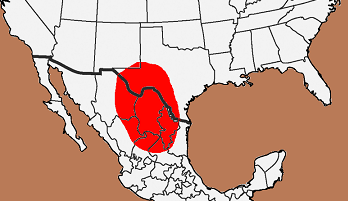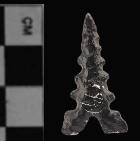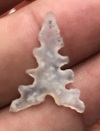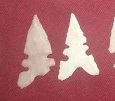Outline is Representative of Size and Shape:

Name Details:
Identified By: Dee Ann Suhm, Alex D. Krieger, Edward B. Jelks
Named For: Toyah Focus named for the town Toyah, Reeves County, Texas
Date Identified: 1954
Type Site:
Identified By: Dee Ann Suhm, Alex D. Krieger, Edward B. Jelks
Named For: Toyah Focus named for the town Toyah, Reeves County, Texas
Date Identified: 1954
Type Site:
Point Validity:
Valid type
Suhm was an eminent Texas anthropologist who, among many distinguished positions, served as Director of Texas Archaeological Research Laboratory. Krieger was a renowned anthropologist who spent most of his career in Texas cataloging projectile points and pottery in Texas before moving on to the University of Washington. Jelks was a distinguished anthropologist and helped organize the newly formed Department of Anthropology at Illinois State University where he was a Professor. His work in Texas furthered the understanding of Texas archeology and was a founding force for the Society of Historical Archeology. This type was named in a professional publication and subsequent book and has many professional references. This is a valid type.
Suhm was an eminent Texas anthropologist who, among many distinguished positions, served as Director of Texas Archaeological Research Laboratory. Krieger was a renowned anthropologist who spent most of his career in Texas cataloging projectile points and pottery in Texas before moving on to the University of Washington. Jelks was a distinguished anthropologist and helped organize the newly formed Department of Anthropology at Illinois State University where he was a Professor. His work in Texas furthered the understanding of Texas archeology and was a founding force for the Society of Historical Archeology. This type was named in a professional publication and subsequent book and has many professional references. This is a valid type.
Toyah Notched
AKA: Frisco Base Notch, Piedras Triple Notch, Saucia Split Base, Saragosa Notched Serrate (all Kelley, 1947), Sierra Madre ( Taylor, 1966) Cluster:
Description of Physical Characteristics and Flaking Pattern:
This is a small triangular side notch point with a flattened cross section. The blade is straight and may have one or more notches on the blade above the shoulders. The notches occur on the blade above the shoulders and up to one third to one half the way up the blade. The stem is expanded. The base is concave and generally has a center basal notch. The basal ears are generally sharp and pointed. This point has a random flaking pattern.
Size Measurements:
Total Length - 15 to 25 mm, Stem Length (to top of notches) - 5 to 10 mm, Blade Width - 9 to 15 mm, Neck Width - 5 to 8 mm, Basal Width - 13 to 20 mm
Total Length - 15 to 25 mm, Stem Length (to top of notches) - 5 to 10 mm, Blade Width - 9 to 15 mm, Neck Width - 5 to 8 mm, Basal Width - 13 to 20 mm
Commonly Utilized Material:
Additional Comments:
This point is similar to the Harrell, but is smaller and has modifications to the blade and corners not seen on the Harrell type. Modifications include notching, deep serrating, and in-cutting (Suhm and Krieger, 1954).
Kelley (1947), Named Saucia Split Base, Saragosa Notched Serrated, Frisco Base Notched, and Piedras Triple Notch. He assigned all of these points to the Toyah Focus. However, he did not discuss how these points were distinguished from each other which has left a lot of confusion of the types. Suhm and Krieger (1954) assigned all of these types together instead of trying to determine key distinguishing characteristic of each of these types. The name Toyah was chosen because this type is associated with the Toyah Focus (Moore, 2015).
Walter W. Taylor (1966) uses the name "Sierra Madre" for this type.
Cloud et al. (1994:126) notes that “Stratigraphic information from the Polvo site suggests that the Toyah type slightly predates Perdiz, that the two types were contemporaneous over an unknown length of time, and that the Perdiz style persisted somewhat later than Toyah.”
This point is similar to the Harrell, but is smaller and has modifications to the blade and corners not seen on the Harrell type. Modifications include notching, deep serrating, and in-cutting (Suhm and Krieger, 1954).
Kelley (1947), Named Saucia Split Base, Saragosa Notched Serrated, Frisco Base Notched, and Piedras Triple Notch. He assigned all of these points to the Toyah Focus. However, he did not discuss how these points were distinguished from each other which has left a lot of confusion of the types. Suhm and Krieger (1954) assigned all of these types together instead of trying to determine key distinguishing characteristic of each of these types. The name Toyah was chosen because this type is associated with the Toyah Focus (Moore, 2015).
Walter W. Taylor (1966) uses the name "Sierra Madre" for this type.
Cloud et al. (1994:126) notes that “Stratigraphic information from the Polvo site suggests that the Toyah type slightly predates Perdiz, that the two types were contemporaneous over an unknown length of time, and that the Perdiz style persisted somewhat later than Toyah.”
Distribution:

Distribution Comments:
This point is primarily found in the Trans Pecos region of Texas, Chihuahua, Coahuila and Tamaulipas Mexico. There is a greater frequency of this type in northern Mexico than into Texas. May be found into the Rio Grande River Valley with decreased frequency. Rarely found in central Texas.
This point is primarily found in the Trans Pecos region of Texas, Chihuahua, Coahuila and Tamaulipas Mexico. There is a greater frequency of this type in northern Mexico than into Texas. May be found into the Rio Grande River Valley with decreased frequency. Rarely found in central Texas.
Age / Periods:
Date: 600 - 300 B.P.
Cultural Period: Late Prehistoric to Historic
Glacial Period: Little Ice Age
Culture: Jumano Culture
Date: 600 - 300 B.P.
Cultural Period: Late Prehistoric to Historic
Glacial Period: Little Ice Age
Culture: Jumano Culture
Age Details:
This type has been associated with the Toyah Focus, a division of the Central Texas Aspect, the Bravo Valley Aspect and Livermore Focus of the Texas Big Bend northern Chihuahua region, and the Jora Complex of central Coahuila (Moore, 2015)
This type has been associated with the Toyah Focus, a division of the Central Texas Aspect, the Bravo Valley Aspect and Livermore Focus of the Texas Big Bend northern Chihuahua region, and the Jora Complex of central Coahuila (Moore, 2015)






















